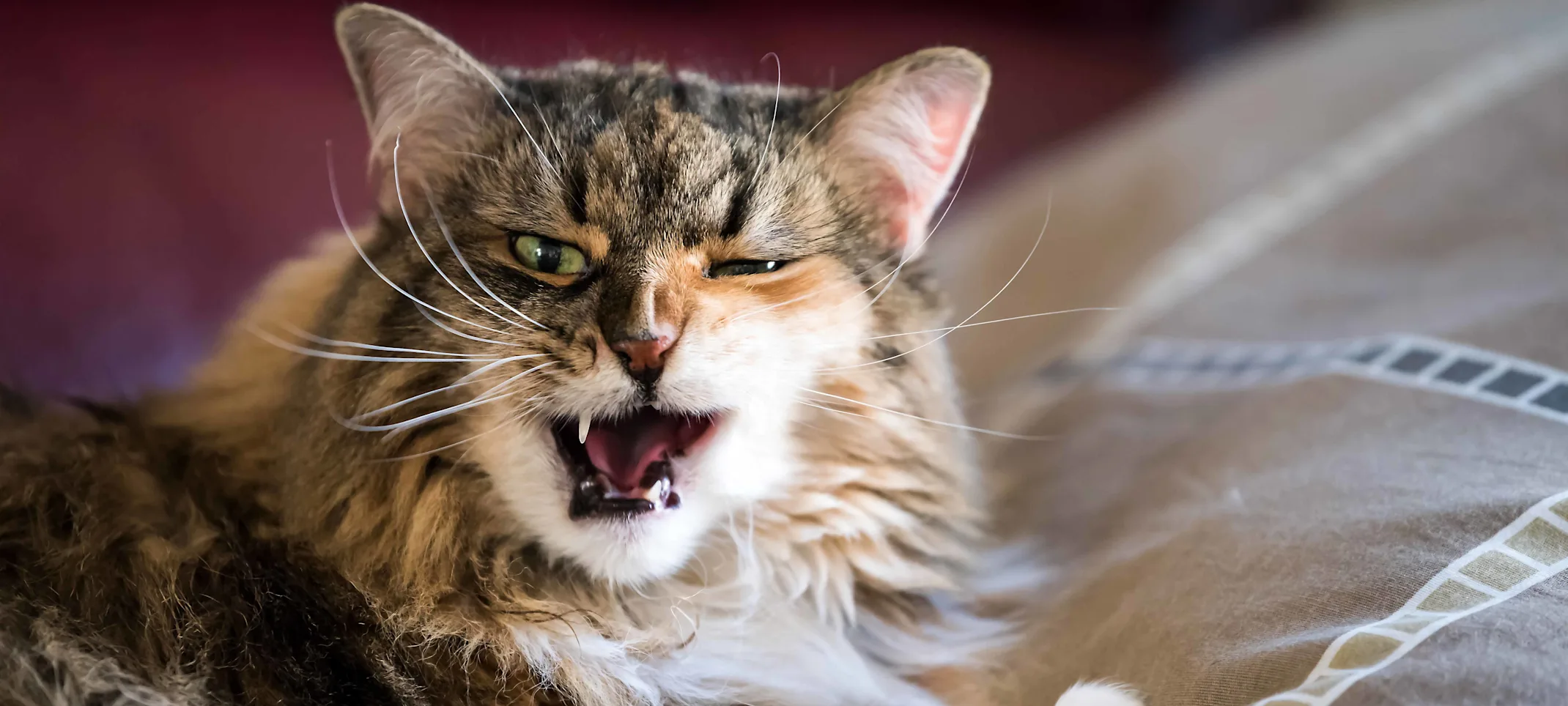Mission Veterinary Emergency & Specialty
Radioiodine I-131 Treatment
Radioiodine therapy, also known as I-131 treatment, is a highly effective and safe option for managing feline hyperthyroidism. The procedure is non-invasive and typically requires only a single injection or oral dose, depending on the protocol followed by the veterinary hospital.

Feline Hyperthyroidism Overview
Feline Hyperthyroidism is a common endocrine disorder affecting older cats, typically those over eight years old. This condition occurs when the thyroid glands located in the neck, become overactive and produce excessive amounts of thyroid hormones. These hormones play a crucial role in regulating the body's metabolism. Symptoms of hyperthyroidism in cats may include weight loss despite increased appetite, excessive thirst and urination, hyperactivity, vomiting, diarrhea, and unkempt appearance.
What is Radioiodine (I-131)?
The thyroid gland is the only tissue in the body that concentrates iodine actively. However, thyroid glands cannot differentiate between normal dietary iodine and radioactive iodine (I-131). Therefore, radioiodine concentrates in the hyperactive, abnormal thyroid tissue, sparing normal thyroid tissue. Radioiodine therapy, also known as I-131 treatment, is a highly effective and safe option for managing feline hyperthyroidism. It involves administering a radioactive form of iodine, I-131, which specifically targets and destroys the overactive thyroid tissue while sparing surrounding healthy tissue. The procedure is non-invasive and typically requires only a single injection or oral dose, depending on the protocol followed by the veterinary hospital.
Benefits of Radioiodine (I-131) Treatment
High Success Rate: Radioiodine therapy offers a high success rate in treating feline hyperthyroidism, with most cats experiencing normalization of thyroid function. Non-Invasive: Unlike surgical thyroidectomy, radioiodine treatment does not require invasive surgery. Minimal Side Effects: The procedure is generally well-tolerated by cats, with minimal risk of complications.Long-Term Management: In many cases, radioiodine therapy provides long-term control of hyperthyroidism, eliminating the need for lifelong medication management.
Our Radioiodine (I-131) Service
At Mission Veterinary Emergency and Specialty, we provide comprehensive care for cats with hyperthyroidism. Our Internal Medicine specialists offer radioiodine (I-131) treatment as a safe and effective option for managing this condition. We prioritize the well-being and comfort of our feline patients, providing personalized care throughout the treatment process.
Radioiodine (I-131) Treatment FAQs
How is the radioiodine administered?
The radioiodine at MVES is administered as a single injection under the skin in the scruff or outer thigh region. Because of the nature of the injection, the patient may need to be lightly sedated to ensure the safety of the pet and staff members involved in the injection procedure and that the pet receives the entire dose.
How long will my cat stay in the hospital after the treatment?
The hospitalization period varies depending on the patient and dose administered, typically about 5-7 days. The effective half-life of I-131 varies based on the patient's ability to be eliminated by their kidneys and the thyroid binding of radioiodine. For this reason, cats with pre-existing kidney disease may require longer stays because their kidneys cannot excrete radioiodine as efficiently. The radioactive emissions from your pet will be monitored at regular intervals to determine when they are able to be released. Your cat can be released from the hospital once the exposure rate from the radioactivity in the body reaches a level that is deemed to be safe to the general public (i.e., owners), established by MVES in conjunction with the Kansas Department of Health.
How will my cat be cared for during their stay?
Your cat will receive attention three times daily from one of our technicians working with one of our Internal Medicine doctors. During this time, your cat will receive routine care (feeding, watering, litter change, cage clean-up) and some social interaction as well as essential monitoring (i.e., attitude, respiratory rate, and effort) and food intake). We operate on a lights-on/lights-off basis. We provide natural lighting and music for our patients during regular daylight hours. We turn off the lights from 6 pm to 8 am, allowing for a somewhat natural life day schedule. You can bring in something familiar from home for your cat (i.e., a blanket or shirt with their scent on it), with the understanding that it will not be returned after the stay because of radiation safety considerations. If your cat requires particular medications, it must be able to be given in food to limit our staff's handling of radioactive patients; medication brought from home must be in its original prescription bottle and label. We go through extensive history taking and review diagnostics performed before the patient's admission for treatment to make sure that we identify any potential abnormalities in cats that may affect your cat before they are admitted for therapy. Due to the high patient radioactivity, our ability to evaluate and treat patients in the radioactive ward is extremely limited by law (e.g. unable to perform CPR or some treatments), even in life-threatening emergencies. Fortunately, it is rare for patients to die during their I-131 hospitalization.
How will I know how my cat is doing?
You may call our hospital for an update once daily after administering the radioiodine. If any significant problem arises, you will be contacted immediately. Visitation with patients while they are in radiation isolation is not allowed.
What happens once my cat is released from the hospital?
When your cat goes home from the hospital, the aftercare includes holding their litter out from regular trash disposal for two weeks. You can place it into a double garbage bag in an unoccupied area or use flushable litter during the two weeks. This is done to prevent others from being exposed to radiation (i.e., sanitation workers) and ensure it passes radiation detectors at most garbage facilities. This litter can be disposed of with your regular trash at the end of the two weeks. Pregnant women and children under the age of 18 years of age should have absolutely no contact with the patient during the initial two-week period. These groups are the most susceptible to radiation hazards (the growing cells in the child's body or unborn child may suffer stunted growth). You will need to limit contact with your cat during the two weeks following discharge from the hospital to limit your exposure to the low level of radiation they emit. This will include having your pet sleep in an unoccupied room, restricting your pet from food preparation areas, and not letting your pet sit on your lap. You should also avoid taking your cat to public housing, such as a hotel, motel, etc, during this same two-week period. Limited (less than one total hour per day) petting is acceptable. Ensure you always wash your hands after any contact with your pet or their eliminations (urine and feces) during these initial two weeks to help prevent the spread of radiation to other regions of the house and decrease potential exposure to you and your family.
What type of monitoring should be done post-radioiodine treatment?
Blood Urea Nitrogen (BUN) and creatinine (kidney values) should be measured at 1 month and three months after the radioiodine treatment. This helps monitor for kidney disease, which can be unapparent while the patient is hyperthyroid but can become clinically noticeable once the thyroid levels have returned to normal. Hyperthyroidism causes increased blood flow to the kidneys, which can “mask” kidney disease that is already present in the older patient group in which both of these conditions are most likely to occur. Radioiodine therapy is NOT associated with causing kidney disease in cats. Thyroid hormone level (T4) is monitored one month and three months after the radioiodine therapy to assess response to the I-131. For the first 3-6 months after I-131, patients may experience subclinical hypothyroidism (low thyroid levels where the patient shows no signs of illness) that usually does not require therapy as the previously atrophied (decreased in size and functional ability) thyroid tissue regains function and the patient’s thyroid level returns to normal. In approximately 5% of cases, some cats may require a second I-131 treatment (if high levels of thyroid hormones persist by 3 months) or thyroid supplementation (if low levels of thyroid hormones persist and develop clinical signs associated with hypothyroidism).
Contact Us
If you suspect your cat may be suffering from hyperthyroidism or have any questions about our radioiodine (I-131) treatment service, please don't hesitate to contact us at 913-722-5566.
